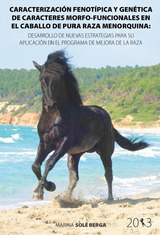Caracterización fenotípica y genética de caracteres morfo-funcionales en el caballo de pura raza menorquina: desarrollo de nuevas estrategias para su aplicación en el programa de mejora de la raza
Phenotypic and genetic characterization of morphofunctional traits in the Menorca purebred horse: development of new strategies to apply in the breeding program of the breed

Ver/
Autor
Solé Berga, Marina
Director/es
Valera Córdoba, M.Gómez Ortiz, M. Dolores
Editor
Universidad de Córdoba, Servicio de PublicacionesFecha
2013Materia
Caballos de Pura Raza Menorquina (PRMe)Équidos
Razas autóctonas
Razas en peligro de extinción
Análisis genético
Características morfofuncionales
Genética
Genealogía
Programas de selección y conservación
Caracterización fenotípica
METS:
Mostrar el registro METSPREMIS:
Mostrar el registro PREMISMetadatos
Mostrar el registro completo del ítemResumen
El Caballo de Pura Raza Menorquina (PRMe) es una raza equina autóctona, catalogada
en Peligro de Extinción según el Catálogo oficial de Razas de Ganado de España (Orden
AAA/251/2012 de 9 de Febrero, por la que se modifica el Anexo I del RD 2129/2008, de
26 de diciembre. BOE-A-2012-2254). Desde 1988 está reconocida como raza pura,
explotándose principalmente en la Isla de Menorca (Islas Baleares -España-). Su
Programa de Mejora Genética se aprobó mediante la resolución del 10 de marzo de 2010
(BOE-A-2010-5478). El Caballo PRMe es un animal adecuado para la equitación,
participando en competiciones deportivas de Doma Clásica y Doma Menorquina, y para la
silla, siendo tradicionalmente el protagonista de las fiestas patronales de Menorca, “El
Jaleo”.
En cualquier raza equina en Peligro de Extinción, que se seleccione en función de su
rendimiento morfo-funcional, es preciso realizar, como paso previo a la puesta en marca
de un Programa de Mejora, una caracterización fenotípica de los rasgos de mayor interés
para la raza que se quieran seleccionar y las relaciones existentes entre ellos. En
segundo lugar, es necesario realizar un análisis genético de los caracteres morfofuncionales
seleccionados, determinando sus parámetros genéticos (heredabilidades y
correlaciones genéticas) con el fin de precisar las variables más adecuadas en las que
basar la selección de los reproductores de la población. Y por último, es preciso
establecer, en base a la información genealógica, molecular y genética, el diseño de un
programa conjunto de selección y conservación de la raza que permita asegurar su
supervivencia, haciéndola competitiva en el entorno económico donde se desarrolla. Por
ello, la presente Tesis Doctoral se ha estructurado en tres capítulos:
? Capítulo 1: “Caracterización fenotípica de caracteres morfo-funcionales del
Caballo Pura Raza Menorquina”
? Capítulo 2: “Análisis genético de caracteres morfo-funcionales del Caballo Pura
Raza Menorquina”
? Capítulo 3: “Desarrollo de estrategias conjuntas de selección y de conservación
de la biodiversidad genética en el Caballo Pura Raza Menorquina”
En el primer capítulo se ha abordado una caracterización fenotípica a partir de distintas
variables morfo-funcionales analizadas en el Caballo PRMe. Para ello, se realizaron 47
medidas zoométricas y se estimaron 10 índices corporales a 147 hembras y 200 machos
de la raza (con edades comprendidas entre 4 y 14 años), durante los años 2009 y 2010.
Los machos se clasificaron en tres grupos, en función de su aptitud funcional (Doma
Clásica, Doma Menorquina y Ocio), determinando mediante un test Duncan múltiple y un
análisis de Componentes Principales (PCA) las diferencias morfo-funcionales existentes
entre los tres grupos... The Menorca Purebred horse (PRMe), is an autochthonous equine breed, catalogued as
in Danger of Extinction (Official catalog of Livestock Breeds in Spain – in the latest update
included in Order AAA/251/2012 (9 February), which modified Annex I of RD 2129/2008
(26 December) BOE-A-2012-2254). Since 1988, it has been recognized as a Purebred,
and is exploited mainly on the island of Menorca (Balearic Islands, Spain). Its Breeding
Program was approved by the resolution dated 10 March 2010 (BOE-A-2010-5478). The
PRMe is an equine breed suitable for riding, which participates in both Classic and
Menorca Dressage competitions, and is especially suitable for saddle, which makes it the
protagonist of the popular festivities of Menorca, "El Jaleo".
In any equine breed in Danger of Extinction to be selected for its morpho-functional
performance, an essential previous step before starting a Breeding Program is the
phenotypical characterization of the most interesting features of the breed to be selected
and the relations between them. Secondly, it is necessary to carry out a genetic analysis of
the morpho-functional characters selected, and determine their genetic parameters
(heritabilities and genetic correlations). The results obtained could allow us to determine
the variables on which to base the selection of the breeding population. And finally, we
must establish, based on genealogical, molecular and genetic information, the design of a
joint program of selection and preservation of the breed which would ensure its survival
and make it competitive in the economic environment in which it is bred. This Doctoral
Thesis has therefore been divided into three chapters:
Chapter 1: “Phenotypical characterization of morpho-functional characters of the
Menorca Purebred horse”
Chapter 2: “Genetic analysis of morpho-functional characters of the Menorca
Purebred horse”
Chapter 3: “Design of joint strategies for selection and the conservation of
genetic biodiversity of the Menorca Purebred horse”
In the first chapter, a phenotypical characterization of the different morpho-functional
variables analyzed in the PRMe breed is presented. To accomplish this, 47 body
measurements were taken and 10 body indices were estimated for 147 females and 200
males of the breed (between 4 and 14 years old), during the years 2009 and 2010. The
males were classified into three different performance aptitude groups (Classical
Dressage, Menorca Dressage and Leisure), and a Duncan's multiple-range test and a
Principal Component Analysis (PCA) were used to determine the existing differences
within the three groups.
For the functional analysis, 35 PRMe stallions (aged between 3 and 10 years old) were
recorded, under the same experimental and environmental conditions, using a 3D
semiautomatic movement analysis system. The functional characterization was carried out
for a total of 24 kinematic variables (temporal, linear, and angular) at the handled walk and
trot. Moreover, the effect of the hindlimb pastern angle (<60º or ≥60º) on kinematic traits...
